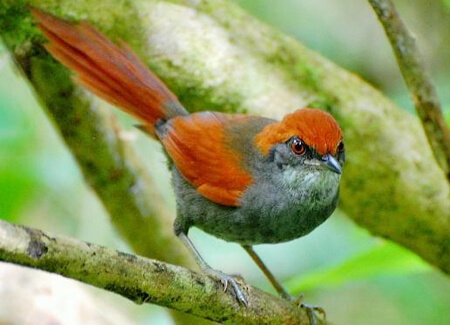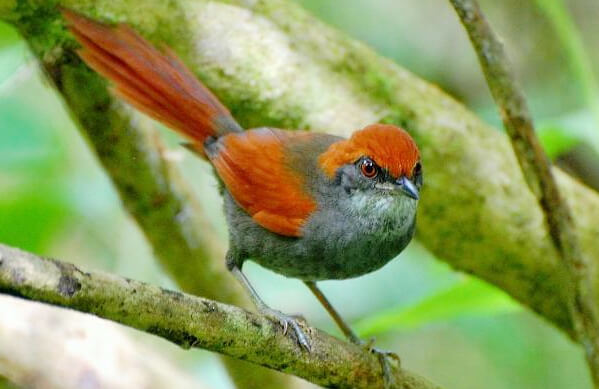 Pinto's Spinetail belongs to the Ovenbird, or Furnariidae, family. (This large group is only distantly related to the familiar North American Ovenbird, a wood-warbler). Furnariidae includes other rare species such as the Royal Cinclodes of Peru and Bolivia.
Pinto's Spinetail belongs to the Ovenbird, or Furnariidae, family. (This large group is only distantly related to the familiar North American Ovenbird, a wood-warbler). Furnariidae includes other rare species such as the Royal Cinclodes of Peru and Bolivia.
Like other spinetails, Pinto's Spinetail is characterized by a long, graduated, double-pointed tail that appears “spiny.” The species is nonmigratory and found only in northeast Brazil—an area where just two percent of native forest remains. Its steep decline is tied to ongoing habitat loss.
Similarity of Spinetails
Pinto's Spinetail is also known as the Plain or Alagoas Spinetail. The birds are subtly colored in grays and browns, adaptations that accompany the spinetails' secretive, skulking lifestyle. Males and females look similar, although males overall may be slightly larger, and both show bright rufous wing-coverts and caps.
This species can be difficult to distinguish from other spinetails by sight, as most have similar plumage. Pinto's can be identified by its minute-long trill. The species' loud call is a series of sharp, nasal enk-enk notes (heard in the audio file above).
Sign up for ABC's eNews to learn how you can help protect birds

Pinto's Spinetail by Stephen J. Jones
Pinto's Spinetails tend to forage alone or in pairs near the ground in dense tangles and thickets, probing for insects and other arthropods in clusters of dead leaves. They also glean their prey from foliage, dead leaves, and small branches.
Nesting in the Round
Pinto's Spinetails are monogamous and, like Bald Eagles and Waved Albatrosses, often mate for life. Pairs sing in duets to defend their nesting territories and strengthen their pair bond.
Like other spinetails in the Synallaxis genus, Pinto's Spinetail builds a globe-shaped nest of sticks and leaves with a tunnel-like side entrance, which is thought to help deter predators. (Sprague's Pipit is another bird that builds a nest with a concealed side entrance.)
Both male and female work together to build the nest, incubate the clutch of two eggs, and feed the young. The nest is built low to the ground on a tangle of branches or in the fork of a tree, sometimes among bromeliads as with the Seven-colored Tanager. Old nests are sometimes refurbished and reused from year to year.
Last Stand for the Spinetail?
Pinto's Spinetail has a tiny range—less than 30 square miles—in the rapidly disappearing Atlantic Forest of northeast Brazil. Although the species appears to tolerate some degree of habitat fragmentation, its habitat is disappearing quickly and the species could become extinct before long.
One of the few places where Pinto's Spinetail may be found is the Serra do Urubu reserve, where ABC and SAVE Brasil are collaborating to buy additional land. You can help: Donate today and help us take advantage of this opportunity to save some of Brazil's rarest species. Or learn more about this effort to conserve the Serra do Urubu's unique forest.
Donate to support ABC's conservation mission!



















































